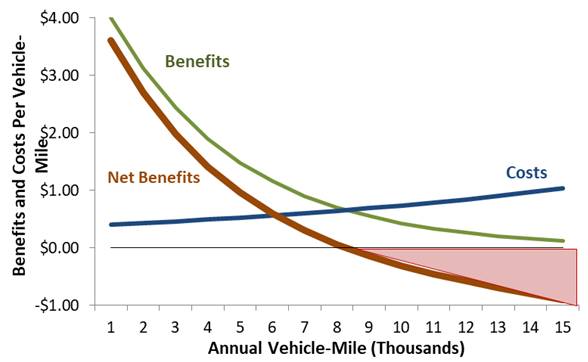
Too Much of a Good Thing: The Consequences of Excessive Vehicle Travel
It’s a well-known saying that too much of a good thing is not good. This holds true for many aspects of life, including food and transportation. While both are essential for our well-being and happiness, overindulging in the wrong types of food or relying too heavily on automobiles can have negative consequences. In this article, we will explore the harmful effects of excessive vehicle travel and the need for smarter transportation planning.
The Impact of Excessive Vehicle Travel
Just as eating too much unhealthy food can lead to obesity and other health issues, relying too heavily on automobiles can have detrimental effects. Excessive vehicle travel is not only costly but also unhealthy and environmentally harmful. Older policies that prioritize the production of sweet and rich foods, such as corn, milk, and beef subsidies, are inappropriate for addressing the obesity epidemic. Similarly, outdated transportation planning practices that prioritize automobile travel without considering other modes or goals fail to serve the needs of those who cannot or prefer not to drive. These planning practices contribute to increased costs and economically-excessive automobile travel, which could be avoided if better options and incentives were available.
Exploring the Issue
In the report “Are Vehicle Travel Reduction Targets Justified? Why and How to Reduce Excessive Automobile Travel,” I delve deeper into this issue. I also co-authored an informational report titled “Vehicle-Miles Traveled as a Metric for Sustainability,” which was published by the Institute of Transportation Engineers. Both reports provide valuable insights into the negative impacts of excessive vehicle travel and offer potential solutions.
The Need for Change
This is an important and timely issue. Per capita motor vehicle travel has been steadily increasing throughout the twentieth century but peaked around 2005. Current demographic and economic trends, such as an aging population, rising vehicle costs, changing consumer preferences, increased teleworking and working from home, and growing concerns about health and the environment, are driving the demand for non-auto travel. It is crucial that we reassess our transportation planning goals and find better ways to achieve them.
Benefits and Costs of Vehicle Travel
While vehicle travel provides certain benefits, such as convenience and mobility, it also imposes costs. As per capita vehicle travel increases, the marginal benefits tend to decline, while the costs tend to increase. This is due to factors such as increased congestion and the displacement of other modes of transportation. As a result, the net benefits of excessive vehicle travel decline and can even become negative at high levels of annual mileage.
The Case for Non-Auto Modes
As per capita vehicle travel increases, so does the need for policies that promote and improve non-auto modes of transportation. For example, as vehicle traffic increases in a city, so do the costs associated with expanding roads and parking facilities, as well as the costs of crashes and pollution. This justifies investments in resource-efficient modes such as walking, bicycling, and public transit, as well as transportation demand management (TDM) incentives to discourage driving and encourage mode shifts.
The Importance of Multimodal Planning
It is essential to prioritize multimodal planning for the sake of fairness. A transportation system should serve the diverse demands of its users, including those who cannot, should not, or prefer not to drive. Unfortunately, many current planning practices favor automobile travel over other modes and contribute to sprawl rather than compact development. This results in automobile-dependent communities where residents are forced to spend more time and money on driving than they would choose to if better mobility options were available. By shifting towards more multimodal planning, we can create communities where people have access to a variety of transportation options and can meet their needs with less reliance on automobiles.
Setting Vehicle Travel Reduction Targets
Many jurisdictions are now setting vehicle travel reduction targets and implementing transportation demand management (TDM) programs to achieve them. These targets vary from region to region, with some aiming to reduce vehicle travel by 20-40% by specific years. These targets align individual decisions with long-term strategic goals, creating more diverse and efficient transportation systems. Critics argue that such policies are inefficient and unfair, but research indicates that reducing vehicle travel can lead to economic, social, and environmental benefits. Surveys show that many motorists would prefer to drive less and rely more on non-auto modes if they were convenient, comfortable, and affordable.
Reforming Transportation Planning
To achieve more efficient and equitable transportation planning, several reforms are needed. These include:
- Responding to consumer demands by prioritizing multimodal planning and considering non-auto demands
- Ensuring fair share resource allocation by investing in non-auto modes and implementing more multimodal planning
- Implementing efficient pricing mechanisms such as fuel taxes, road tolls, parking fees, and emission fees
- Adopting comprehensive planning that aligns short-term decisions with long-term goals
- Evaluating performance based on accessibility and optimizing transportation systems accordingly
Conclusion
In conclusion, excessive vehicle travel has significant negative consequences for individuals, communities, and the environment. By setting vehicle travel reduction targets and implementing smarter transportation planning practices, we can create more diverse, efficient, and equitable transportation systems. These changes will not only benefit the environment but also improve public health, reduce congestion, and enhance the overall quality of life. It’s time to prioritize non-auto modes and rethink our transportation planning goals to create a better future for all.
Quote from the Author
“Excessive vehicle travel is not only costly but also unhealthy and environmentally harmful. By reducing our reliance on automobiles and prioritizing non-auto modes of transportation, we can create more sustainable and equitable communities.” – [Author Name]
Author’s Conclusion
Excessive vehicle travel is a pressing issue that requires immediate attention. By implementing vehicle travel reduction targets and adopting smarter transportation planning practices, we can create a more sustainable future. It’s time to prioritize non-auto modes and shift towards a more balanced and efficient transportation system.” – [Author Name]

George Barham, an accomplished journalist and avid gambling enthusiast, serves as the esteemed Editor-in-Chief at fly-to-australia.com, Australia’s leading source for comprehensive gambling news and insights. With an unwavering passion for both the written word and the ever-evolving world of betting and gaming, George brings a wealth of knowledge and expertise to the helm of our editorial team.



